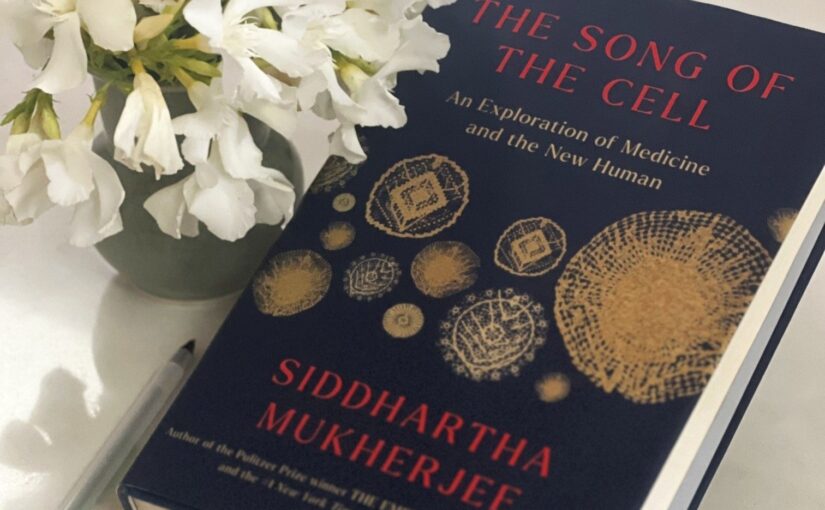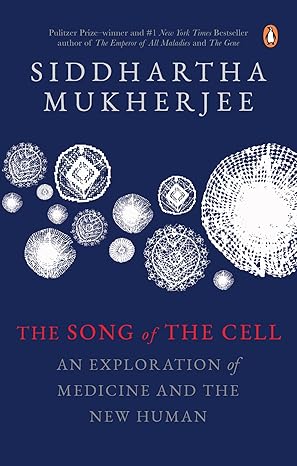“Mukherjee expresses abstract intellectual ideas through emotional stories… and swaddles his medical rigor with rhapsodic tenderness, surprising vulnerability, and occasional flashes of pure poetry.”
This is what The Washington Post wrote about Siddhartha Mukherjee’s The Song of the Cell. I am sitting in my study with the book on my table and looking at the window as an August rain in downtown Kolkata splashes on the windowpanes, obscuring the landscape outside.
It’s a fitting metaphor. The rain blurs the world outside, just as Mukherjee’s book clarifies the world within. If cells have songs, our selves made out of them must be a choir. I wonder. The book, each of its 473 pages, had been a revelation for me. Outwardly scholarly, Mukherjee weaves a tapestry of a journey so magnificent yet so personal that it will leave a lasting impression on me. The subject is too enormous even to attempt a summary, but as a reader I will ever be grateful for the connections made. Because if cells sing, they sing in me as well, as they sang in countless many before me and will sing in many yet to walk this planet. Each of these men and women, including the ones I know and consider my kin, is an expressed concert. And if Mukherjee is right—he certainly makes a compelling argument—this concert or the playlist of songs that we call physiology is changing bit by bit with new research and new medicine.
Mukherjee’s genius lies not just in his ability to explain the science of the cell, but in his capacity to make it feel like a story we’ve always known but never quite understood. He begins with the birth of cellular theory, tracing its origins to the 17th century when Robert Hooke first peered into a cork and saw what he called “cells.” From there, the narrative expands outward and inward—into the history of medicine, into the future of biotechnology, and into the deeply personal terrain of human suffering and healing.
Couple of years ago, I nursed my CVA-affected mother for two years, closely observing the slow shutting down of her brain – a person with the sharpest of minds inexorably sliding into a vegetative state. I saw up close how the playlist progressively lost its genre, then missed the songs, then mixed up rock with rap, finally just a garbled mixture of notes was what was left of her. She died because in the end she forgot how to eat and her guts forgot how to digest food. I remained witness to a disintegration of a cellular citizenry.
Mukherjee’s book gave me language for that grief. He writes of neurons—those majestic, irreplaceable cells that do not divide or renew once matured. They are the keepers of memory, the architects of thought, the conductors of our internal symphony. When they falter, the music fades. My mother’s decline was not just a medical event; it was a slow silencing of a once vibrant choir. And yet, Mukherjee offers hope. Scientists can now coax stem cells into becoming neurons in petri dishes. One day, perhaps, CVA damage can be repaired. Perhaps the choir can be taught to sing again.
Mukherjee’s metaphor of the cell as a citizen in a vast biological republic is one of the book’s most powerful conceits. Each cell has a role, a function, a voice. Some are solitary monks—like neurons—while others are bustling workers—like immune cells or epithelial cells. Together, they form tissues, organs, systems. Together, they sing the song of life.
But what happens when the song goes awry? Disease, Mukherjee argues, is not merely a malfunction of parts but a breakdown of harmony. Cancer is a rebellion. Autoimmune disorders are cases of mistaken identity. Infections are invasions. The body, like any society, must constantly negotiate cooperation and conflict.
This framing transforms medicine from a mechanistic endeavor into a moral one. Healing is not just about fixing what’s broken; it’s about restoring dialogue, rebuilding trust, reestablishing rhythm. Mukherjee’s prose—elegant, precise, and often poetic—guides the reader through this terrain with both intellectual rigor and emotional depth.
Mukherjee’s own life threads through the book like a quiet melody. He writes of patients he has treated, of family members he has lost, of moments when science failed and when it triumphed. These stories are not digressions—they are the heart of the book. They remind us that behind every cell is a person, and behind every person is a story.
One of the most moving chapters recounts the development of CAR-T cell therapy, a revolutionary treatment for certain cancers. Mukherjee describes the science in detail, but he also introduces us to the children whose lives were saved by it. Their names, their faces, their recoveries—they linger long after the technicalities fade.
This is where Mukherjee excels. He does not merely inform; he evokes. He does not merely teach; he transforms. Reading The Song of the Cell is not just an intellectual exercise—it is an emotional journey.
Mukherjee’s scope is vast. He traverses centuries and continents, from the early anatomists of Europe to the cutting-edge labs of modern America. He explores the politics of medicine, the ethics of biotechnology, the promises and perils of genetic engineering. He is unafraid to ask difficult questions: What does it mean to be human in an age when we can redesign our biology? How do we balance innovation with caution? Who gets access to these miracles?
And yet, despite the complexity, the book never feels overwhelming. Mukherjee is a master of structure. Each chapter builds upon the last, each idea is contextualized, each term is explained. The reader is never lost, even when the terrain is unfamiliar.
As science progresses, taking medicine under its wings, Mukherjee hints that disease is as much a cellular pathology as a loss of cooperation between them, like an ecology gone wrong. In order to fight the ever-evolving pathogens and mutations that challenge homeostasis, we must evolve parallely with new scripts of our genomes. In essence then, to live healthy, we must rejuvenate into new humans. You have become one if you got a jab of the Covid vaccine, or had a bone marrow transplant.
This idea—that medicine is not just about survival but about transformation—is one of the book’s most provocative themes. Mukherjee suggests that we are entering an era where we can rewrite the very code of life. CRISPR, stem cell therapy, immunomodulation—these are not just tools; they are instruments in a new symphony of healing.
But with this power comes responsibility. Mukherjee is careful not to indulge in utopian fantasies. He acknowledges the risks, the unknowns, the ethical dilemmas. He invites the reader to think critically, to question, to participate in the conversation.
Neurons are cells that do not divide or renew once matured. My mother was a living—or dying—testimony. But now scientists can create them from stem cells in petri dishes. So one day CVA damage of brains can be repaired, hopefully, with reengineered neurons. Will we be the same with a new brain? Will the new choir, the new playlist be as magnificent as we are now?
This question haunts me. It is not just a scientific query—it is a philosophical one. What makes us who we are? Is it the arrangement of cells, the firing of synapses, the chemistry of neurotransmitters? Or is it something more—something ineffable, something that cannot be replicated in a dish?
Mukherjee does not offer easy answers. He respects the mystery. He honors the unknown. And in doing so, he elevates the book from a work of science to a work of art.
Siddhartha Mukherjee’s book left the question unanswered. Like the obscure windowpanes of my study. I loved this challenge so dearly.
As the rain continues to fall outside, I find myself returning to the book—not to reread, but to relive. It is not just a text; it is a companion. It has changed the way I see my body, my family, my grief, my hope. It has taught me that science is not cold—it is luminous. That medicine is not mechanical—it is musical. That cells are not silent—they sing.
And if they sing, then perhaps we are all part of a grand, unfinished symphony.
Related Reading
![]()


